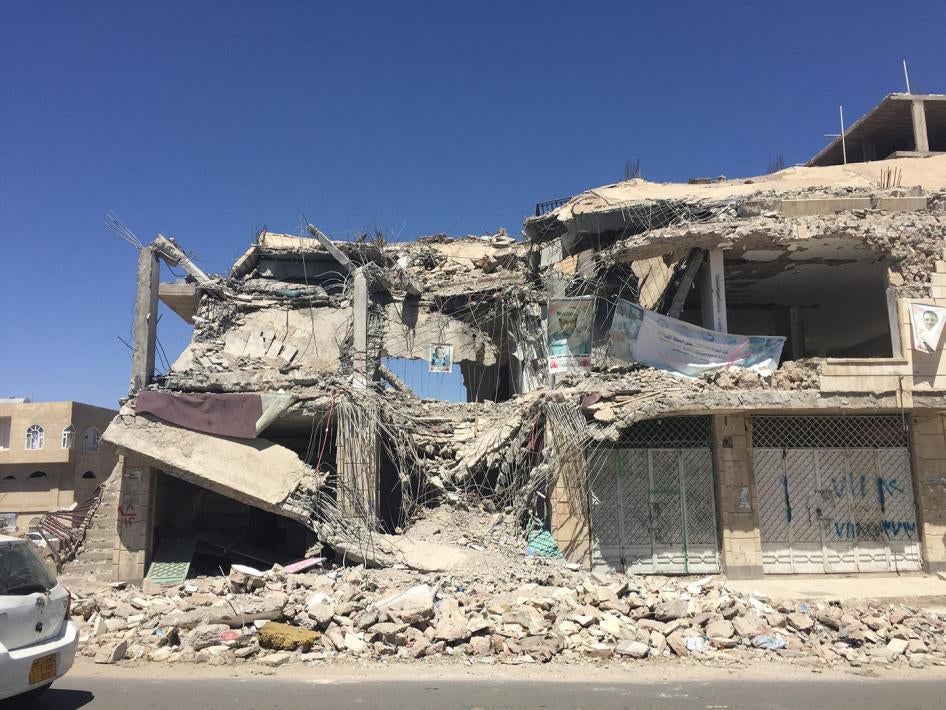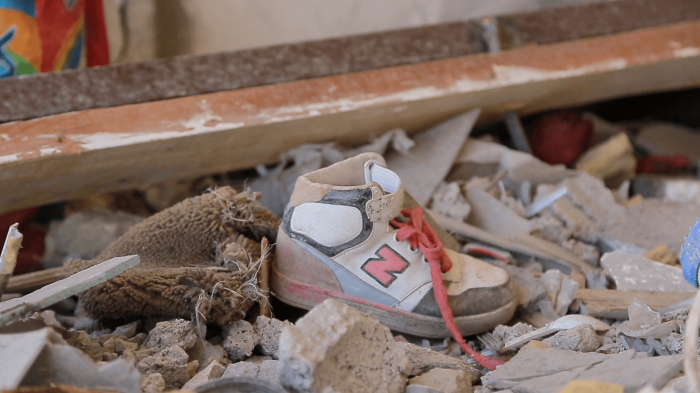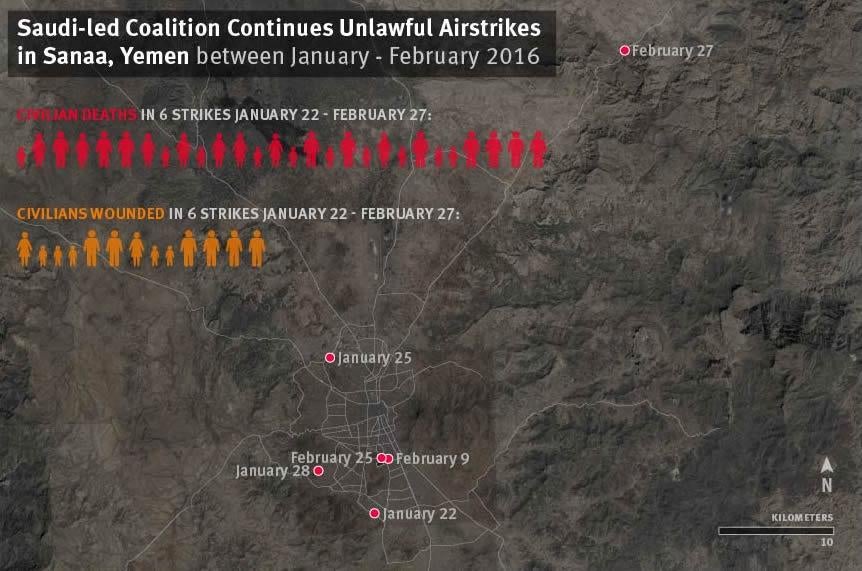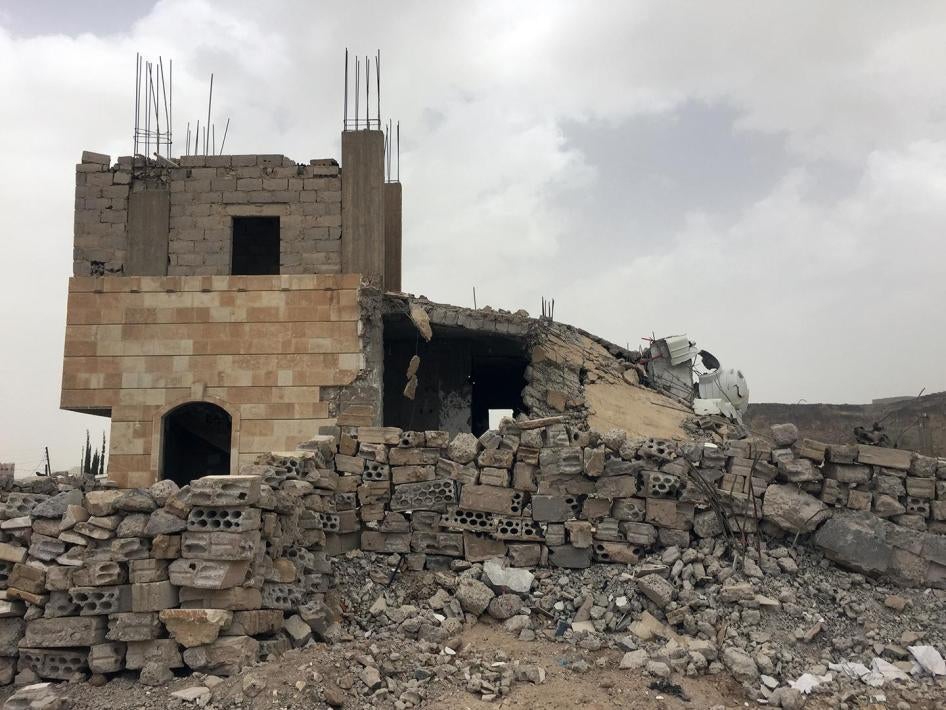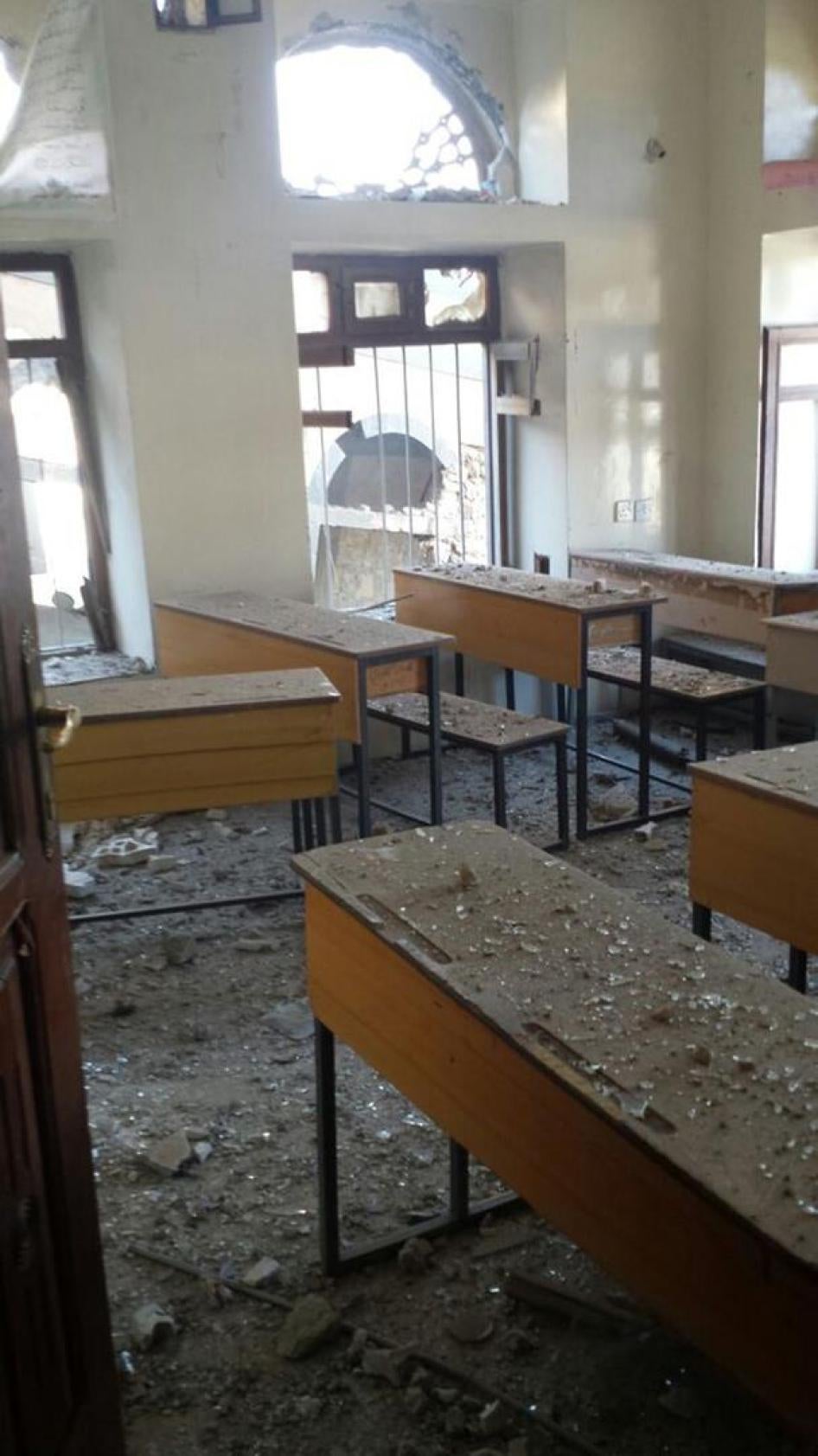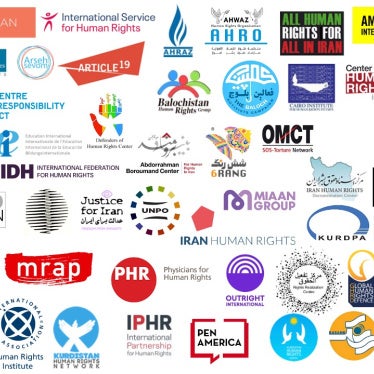(Beirut) – Participants to the Yemen peace talks should support international investigations, transitional justice, and victim compensation as key elements of any agreement. The United Nations-backed talks began in Kuwait on April 21, 2016.
The armed conflict in Yemen has been characterized by numerous violations of the laws of war by all sides, which have not been investigated nor have resulted in any redress for victims of unlawful attacks. The Saudi Arabia-led coalition of nine Arab countries has carried out indiscriminate airstrikes against residential neighborhoods, markets, and other civilian structures causing several hundred civilian casualties. Ansar Allah, the northern group, also known as the Houthis, and other armed groups on both sides have committed various abuses in ground operations. Although a ceasefire was announced on April 10, fighting has continued across Yemen.
“It’s crucial for the Yemen peace talks to address past atrocities as well as future political arrangements,” said Joe Stork, deputy Middle East director. “A mechanism should be put in place to investigate abuses, prosecute those responsible, and assist the victims.”
Human Rights Watch has documented new coalition airstrikes that appear to be unlawful. Six attacks in and around the capital, Sanaa, in January and February, killed 28 civilians, including 12 children, and wounded at least 13 others. In the past year, Human Rights Watch has documented 43 airstrikes, some of which may amount to war crimes, which have killed more than 670 civilians, as well as 15 attacks involving internationally banned cluster munitions. Human Rights Watch has also documented serious laws of war violations by Houthi and other armed groups, including indiscriminate shelling of cities, enforced disappearances, and the use of internationally banned antipersonnel landmines.
Participants at the peace talks include representatives from the Yemeni government of President Abdu Rabbu Mansour Hadi, the Houthis, and the pro-Houthi party of former President Ali Abdullah Saleh. Human Rights Watch is unaware of any investigations by Saudi Arabia or other members of the coalition into allegedly unlawful attacks or abuses, or of any compensation for victims. In their public statements, none of the participants in the talks has indicated a need to include accountability or redress in the peace process.
Any peace agreement should include a mechanism that would allow an independent international investigation into abuses by all sides since the beginning of military operations in the country in late 2014, and provide a path toward prosecuting those responsible. In addition, governments are obligated to provide appropriate compensation to victims of violations of the laws of war.
On August 19, 2015, Human Rights Watch and 22 other human rights and humanitarian organizations called on the UN Human Rights Council to create an independent international commission of inquiry to investigate alleged laws-of-war violations in Yemen. The UN high commissioner for human rights similarly called on UN member countries to encourage the establishment of an “international independent and impartial” investigative mechanism.
Instead, on September 7, President Hadi established a national commission to investigate violations of human rights and the laws of war. During the ensuing UN Human Rights Council session in Geneva, Saudi Arabia and other Arab countries effectively blocked an effort led by the Netherlands to create an international investigative mechanism. The national commission has taken no tangible steps to conduct investigations.
“Yemeni victims have grown tired of waiting for credible justice for the abuses committed against them,” Stork said. “The parties around the negotiating table have an obligation to ensure that the violations against civilians are properly investigated and appropriately punished.”
Bait Baws, Sanaa, January 22, 2016
On January 22, between 11 p.m. and midnight, an airstrike hit the intersection of 24th and 30th Streets, in Bait Baws, a southern neighborhood of Sanaa. Human Rights Watch visited the area on March 24. The strike damaged a single-story home and a storage facility containing clothing across the street. The strike killed one son of the Shabalah family and wounded four other family members.
Abdo Muhammad Murshid Shabalah, 40, was home with his wife and four children at the time of the strike. “I was in a deep sleep and woke up to find that the ceiling had caved in and my children were wounded,” he said. Though the strike did not hit his home directly, the pressure from the blast caused the support beams and ceiling in both of the two front rooms to collapse. Shabalah had to dig out his 9-year-old daughter, Israa, from the rubble. At the hospital, Shabalah learned that his son Mohammed, 11, had died in the attack. Shabalah’s wife and three other children were wounded.
Shabalah did not know why the area had been attacked. “The people here are just civilians and salesmen, and it is a safe area,” he said. He added that that this was the first time coalition forces had struck the Bait Baws neighborhood, though they had hit the al-Nahdain mountains about two kilometers away, where there are caches of Yemeni army weapons under the control of former President Saleh and the Houthis. They had also repeatedly struck the presidential palace, about four kilometers away, since the beginning of the war. Human Rights Watch could not identify any military targets or installation closer to the strike site.
Northern Sanaa, January 25, 2016
On January 25, at 1:30 a.m., an airstrike hit the home of Judge Yahya Muhammad Rubaid, the president of Sanaa’s criminal appeals court, in northern Sanaa, killing five members of the family. Only one son and several bodyguards survived. Human Rights Watch visited the site on March 21, and saw the remains of the three-story house that had been hit.
Sadiq Yahya Rubaid, 25, the only surviving family member, said that he was asleep when the bomb hit his father’s bedroom on the third floor of the house. The son was wounded in the attack, with several broken ribs that punctured his lungs.
Mohsin Muhammad Rubaid, 50, the brother of Judge Rubaid, who lived in a house about 40 meters away, said he came running the moment he heard a loud blast. He found his brother and his brother’s wife lying on the ground 30 meters from their home, by a gas station. “He was still alive but totally confused, we were speaking to him but he didn’t understand anything,” Mohsin Rubaid said. “His wife was lying there too, gasping for breath. She couldn’t breathe even though she didn’t have any visible wounds. They both died later that day in the hospital.”
The strike also killed one of Judge Rubaid’s sons, his wife, and Sadiq Rubaid’s wife, who was six months pregnant. The rest of the bodies were found about 100 meters from the house, across the main road, in front of a supermarket.
Neighbors and Sadiq Rubaid said that the family had armed security guards for protection. The guards were asleep on the ground floor and were unharmed. Before March 2015, there was a Houthi checkpoint right below the house, but neighbors said that once the war started, they had dismantled it. On the day Human Rights Watch visited the destroyed house, a hotel about 120 meters away was filled with Houthi armed fighters. The house is 600 meters from al-Iman University, an institution affiliated with the Islah Party, which opposed the Houthis. During the fighting in September 2014, the Houthis frequently targeted the university and subsequently used it as an ad hoc detention facility.
Media outlets that reported the strike and several human rights activists in Sanaa linked the bombing of Judge Rubaid’s house to a pending criminal case. The public prosecutor on November 17, 2015, had brought charges in absentia against President Hadi and six others for multiple crimes. The charges included sabotaging and destroying military sites and equipment, highways, bridges, public roads, and warehouses; exposing Yemen’s military secrets and sharing maps and other information about military sites; causing economic collapse by preventing the import of food, medicine, and fuel by air and sea; killing and wounding thousands of civilians; and destroying more than 71,000 houses, 1,300 schools, 70 mosques, 40 sports facilities, and 34 artistic and technical institutes and archeological sites. The activists said that while the case was still before the court of first instance, it was likely to come before Judge Rubaid on appeal in the coming months.
Faj Attan, Sanaa, January 28, 2016
On January 28, at about 10:30 p.m., an airstrike hit the home of the al-Haj family in a residential neighborhood in southwest Sanaa, 500 meters from the base of the Faj Attan mountains. The attack killed six civilians, including four women and a child. Since the war began, the coalition has repeatedly bombed the mountains, where there are caches of Yemeni army weapons under the control of former President Saleh and the Houthis. Because of the repeated strikes, the family had left their home and had only returned on January 27, to check on the house, staying overnight. Human Rights Watch visited the site on March 23.
Safwan Muhammad al-Mansub, a security guard nearby, told Human Rights Watch that three airstrikes hit the mountains just a few minutes apart, at about 10:40 p.m. After the second strike, he ran to the al-Haj home to tell the family to leave the area. The family members told him the head of the household, Aidrous Muhammad al-Haj, had gone out to buy dinner, so they would wait for his return. Just as the third strike hit the mountain, al-Haj returned and then tried to usher his family out of the house and into the car, while al-Mansub held open the gate in their yard. As the family was gathered in the entry hall, a fourth strike hit the house directly.
Mansub and another guard in the area, al-Azaa Mohsin, 40, said strikes continued in the area until about 1 a.m., the rest hitting the surrounding mountains. They estimated that 18 strikes hit the area that night.
Mohsin said:
We only found the body of Aidrous, the father, the next day, and we were too scared to come back sooner, as were the ambulances. We found his wife in the corner by the entrance, with her hands still on her head, and their daughter Asil… we just found the top half of her body, up to her chest, flung out on the dirt track outside the house.
Al-Haj’s son, Ali, 24, who survived the strike because he was sleeping at a relative’s house that night, said that everyone in the house that night was killed: his father Aidrous, about 50; his mother, Malka, about 45; his sister Asil, 18; his brother Muhammad, 14; and his two aunts Raba’a Ali al-Haj, 43, and Umm al-Kheir al-Haj, 41. Ali and both security guards said that Aidrous al-Haj worked as a public affairs officer at a cardiac clinic in Sanaa and that the family had no military affiliations.
Human Rights Watch could not identify any military targets or installation at the site of the attack. The guards estimate that the mountains have been bombed more than 550 times since the beginning of the war.
Bait Maiyad, Sanaa, February 9, 2016
On February 9, at about 9 p.m., an airstrike hit a home at 60 Meter Street in the Bait Maiyad neighborhood of southern Sanaa, killing a family of five, including one woman and three children. The house is a few meters from the Shaqa’iq al-No’man school, which has 300 students, and about 600 meters from the presidential palace, which coalition aircraft have targeted throughout the war. Human Rights Watch visited the site of the attack on March 27, by which point the remains of the home had been removed. The windows and some walls of the school were damaged in the airstrike, and this damage was still visible.
Mahdi Muhammad Abdullah Maiyad, 40, a neighbor, said that he was walking in the neighborhood at the time of the strike:
Suddenly I saw a flash of light to the west, and then a loud explosion followed seconds later. I thought it was coming from the presidential palace. I ran home to check on my family and just as I got there, about three minutes later, a second explosion blasted from the same spot – not the presidential palace but the home of Mounir al-Hakimi and his family.
Fursan Muhammad Hazza’a, 24, a security guard at Shaqa’iq al-No’man, was inside the school at the time of the strike on al-Hakimi’s home. He rushed outside after hearing an explosion and saw the building on fire. He heard al-Hakimi’s wife, Sua’d Ali Houjera, 35, screaming for help, as well as the cries of their sons Rami, 10, and Majd, 8. “I wanted to rush into the fire to save them, but within a few minutes an explosion broke out in the garage behind the home,” he said. The strike killed the whole family, including their daughter, Nouran, 2.
Muhammad Ali al-Dari, 18, a student at the school, was at a nearby shop at the time of the strike. “Rescuers could not collect some of the bodies buried under the rubble for a week, after the debris had been removed,” he said. He showed Human Rights Watch photos he took from inside the school the day after the attack: “The strike completely burned out some classrooms, and all the walls were scorched.” He and others from the neighborhood spent two days removing debris and broken glass from the building before students could use it again.
Two witnesses said that several minutes after the strike on the al-Hakimi home, another strike hit a small hangar a few meters away housing vehicle oils and fluids, destroying it. Al-Dari said that the hangar was not being used for any military purposes. The security guard Hazza’a did not believe there had been a second airstrike, but instead thought the fire caused by the first airstrike set flammable liquids in the hangar on fire, causing a second explosion.
Al-Lail, Sanaa, February 25, 2016
On February 25, at about 12:30 a.m., an airstrike hit a road 450 meters north of the presidential palace in Sanaa, in the neighborhood of al-Lail, damaging two houses about five meters away, killing one civilian and wounding four, including two children.
Muhammad Hussein al-Raidy, 57, a local resident, told Human Rights Watch he was asleep at home with his wife and nine children when the wooden roof collapsed on top of him. He was able to remove the rubble, and ushered his wife and four of his children outside. He rushed back in to find the other three. Two of them, Thuriya, 12, and Bashar, 9, had minor wounds from the collapsed roof. His neighbors took the two children to a nearby hospital, and al-Raidy headed to the home of his father-in-law, Muhammad Ali Abdullah al-Ibbi, a few meters away. Al-Raidy said:
As I approached the house, I heard the voice of Muhammad, my relative calling for help. My neighbors and I went into the house and saw my mother-in-law Mu’ajaba Muhammad Ali, with only her head sticking out of the pile of rubble. After we pulled her out, we asked where her husband was, and she said, “He is gone.” We then found Muhammad Khaled; he had wounds from metal fragments to his chest and shoulder. Later we found part of my father-in-law’s body, which was in four or five pieces.
Mu’ajaba Muhammad Ali told Human Rights Watch that she suffered several injuries from the airstrike.
Nihm district, February 27, 2016
On February 27, between noon and 12:30 p.m., two airstrikes hit the village of Khulqa in the Nihm district, about 40 kilometers northeast of Sanaa. Fighting between pro-Houthi forces and fighters supported by the coalition and the Yemeni government in Nihm had begun early in 2016. The first strike hit the middle of a small, crowded local market, killing at least 10 civilians, including one woman and four children, and wounding at least four more. The second strike landed 150 meters away in a graveyard between five and 10 minutes later, causing no injuries.
Yahiya Ahmad Mabkhout al-Qash’a, a resident of Khulqa, told Human Rights Watch that on the morning of February 27, his relatives in Maswara village, 25 kilometers closer to the front line, left their village for Sanaa to avoid the fighting. Four of al-Qash’a’s cousins, including two women, and two of his friends got into three cars and drove to Khulqa. While they were in the village at noon, an airstrike hit the cars, killing three of al-Qash’a’s cousins, his two friends, and five other people in the marketplace, including four children. Only one of his cousins, Khamsa Muhammad Muhammad al-Barqe, 35, survived.
Rageh Mohsen al-Gradi, 46, the local sheikh, arrived at the site of the strike 30 minutes later and saw the three cars on fire, and seven or eight dead bodies on the ground. He recognized three local children killed in the strike. The strike also wounded four local residents, he said.
Gafer Muhammad Nasser al-Gradi, a Khulqa resident, said that since fighting had begun in Nihm district, the Houthis were using the main road that cuts through the village and market, connecting Sanaa, Nihm and Marib, on a daily basis. However, he was in the market that day and did not see any Houthis or Houthi vehicles on the road for at least one hour before the strikes.
